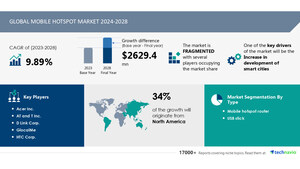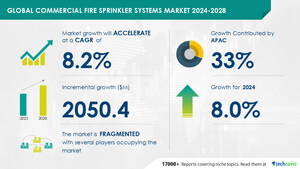NEW YORK, May 15, 2024 /PRNewswire/ -- The global smart city market size is estimated to grow by USD 288.7 bn from 2023-2027, according to Technavio. The market is estimated to grow at a CAGR of 24.53% during the forecast period.
For more insights on the forecast market size and historic data (2017 - 2021) - Download Free sample report in a few minutes
Forecast period |
2023-2027 |
Base Year |
2022 |
Historic Data |
2017 - 2021 |
Segment Covered |
Application (Smart infrastructure, Smart energy, Smart mobility, Smart security, and Others), Component (Hardware, Software, and Services), and Geography (Europe, North America, APAC, South America, and Middle East and Africa) |
Region Covered |
Europe, North America, APAC, South America, and Middle East and Africa |
Key companies profiled |
ABB Ltd., Accenture Plc, Aeris Communications Inc., Alphabet Inc., Cisco Systems Inc., General Electric Co., Hewlett Packard Enterprise Co., Hitachi Ltd., Honeywell International Inc., Huawei Technologies Co. Ltd., International Business Machines Corp., Itron Inc., LG Electronics Inc., Microsoft Corp., Oracle Corp., SAP SE, Schneider Electric SE, Siemens AG, Sierra Wireless Inc., and Signify NV |
Key Market Trends Fueling Growth
In the rapidly urbanizing Asia Pacific region, smart city development is gaining momentum, driven by population growth and infrastructure needs. Emerging economies like India and China are planning and launching pilot projects, focusing on environmental sustainability, resource management, and public safety through smart city technologies. These solutions include facial recognition, data-driven policing, traffic safety systems, and energy savings measures. Urban sources face tight budgets, requiring cost-effective systems for long-term cost savings. Major functions like emergency response protocols, crime-fighting capabilities, and intelligent surveillance are being addressed through advanced networking, software integration, and big data analytics. Cities like Amsterdam and Chengdu are leading the way with government backing and large-scale investments in smart city infrastructure, including video cameras, gunshot detection sensors, and call centers for field operations and law enforcement responses.
Market Challenges
In the smart city market, the substantial expense of modernizing smart grids poses a significant challenge. This cost includes investments in distribution systems, transmission line replacement, power delivery systems, substation digitalization, and digital controls. Power utilities and independent producers face substantial initial capital requirements due to the outdated power infrastructure and the need for renewable energy grid integration. The near-term cost avoidance by utilities contributes to this barrier, hindering the adoption of smart grid data management solutions. Key aspects of smart cities include commute times, efficiency, transformative potential, cybersecurity, data stewardship, ownership, interoperability, cross-border portability, metrics, sustainable urban development, business leaders, innovative business models, digitalization, connectivity, healthcare, smart metering data, utilities-related information, centralized hubs, IT integration, and advanced metering solutions. Novel technologies such as cloud edge computing, network slicing, and urban management also play a crucial role.
* * The outdated power infrastructure of these utilities and their increasing requirement for renewable power grid integration will escalate their grid renovation budgets in the upcoming years.
* This reluctance to upgrade power grids for smart grid data management solutions stems from the near-term cost avoidance by utilities, acting as a significant barrier to adoption.
* According to the US Department of Energy, US power utility companies are projected to spend approximately $3.5 billion annually between 2018 and 2030 on grid modernization projects.
* The unwillingness of power utility providers to modernize their grids to accommodate smart grid data management solutions is a major concern, potentially impacting the future growth of the global smart city market.
Research report provides comprehensive data on impact of trend, driver and challenges - Buy Report
Segment Overview
This smart city market report extensively covers market segmentation by
- Application
- 1.1 Smart infrastructure
- 1.2 Smart energy
- 1.3 Smart mobility
- 1.4 Smart security
- 1.5 Others
- Component
- 2.1 Hardware
- 2.2 Software
- 2.3 Services
- Geography
- 3.1 Europe
- 3.2 North America
- 3.3 APAC
- 3.4 South America
- 3.5 Middle East and Africa
1.1 Smart infrastructure- In the realm of smart infrastructure, environmental sustainability is a primary focus, particularly in the context of smart city applications. Smart city technologies, such as resource management and environmental monitoring, are integral to this endeavor. Facial recognition and public safety technologies are essential components, ensuring the well-being of citizens. Urban sources, including traffic safety and data-driven policing, are optimized through smart city solutions. These systems enable rapid response times, enabling effective crime-fighting capabilities for first responders. Integration of call centers, field operations, and traffic signal management further enhances efficiency. Energy savings and operational cost reductions are significant benefits, making these systems increasingly attractive despite tight budgets. Major functions, such as emergency response protocols and law enforcement responses, are streamlined through big data analytics, networking, and software integration. Cost-effective systems, offering long-term cost savings, are being adopted in cities like Amsterdam and Chengdu, with government backing. Smart city infrastructure includes advanced technologies like video cameras and gunshot detection sensors, providing public safety officials with real-time information for effective decision-making.
For more information on market segmentation with geographical analysis including forecast (2023-2027) and historic data (2017 - 2021) - Download a Sample Report
Research Analysis
In the Smart City market, environmental sustainability and resource management are key priorities. Smart city technologies, such as facial recognition and environmental monitoring, play a significant role in enhancing public safety and surveillance. These solutions enable data-driven policing, rapid emergency response protocols, and crime-fighting capabilities. However, integration complexities and cost-effective systems are essential considerations for large-scale investments in smart city solutions. Cities like Amsterdam and Chengdu are leading the way with government backing and the use of advanced technologies like video cameras, gunshot detection sensors, and drones. These long-term investments offer significant cost savings through resource efficiency and improved urban sources management. AI access and real-time data analytics are crucial components of smart city solutions, enabling traffic safety and optimizing urban infrastructure.
Market Research Overview
In the realm of modern urban development, the Smart City Market holds significant promise. This market encompasses innovative technologies and solutions designed to enhance city living, improve efficiency, and promote sustainability. Key components include intelligent transportation systems, energy management, and public safety solutions. Smart City Market offerings facilitate seamless connectivity, enabling real-time data analysis and proactive decision-making. Additionally, these solutions foster a more eco-friendly environment through the optimization of resources and reduction of carbon emissions. The Smart City Market is poised to revolutionize urban infrastructure, offering a more livable, efficient, and sustainable future for city dwellers.
Table of Contents:
1 Executive Summary
2 Market Landscape
3 Market Sizing
4 Historic Market Size
5 Five Forces Analysis
6 Market Segmentation
- Application
- Smart Infrastructure
- Smart Energy
- Smart Mobility
- Smart Security
- Others
- Component
- Hardware
- Software
- Services
- Geography
- Europe
- North America
- APAC
- South America
- Middle East And Africa
7 Customer Landscape
8 Geographic Landscape
9 Drivers, Challenges, and Trends
10 Company Landscape
11 Company Analysis
12 Appendix
About Technavio
Technavio is a leading global technology research and advisory company. Their research and analysis focuses on emerging market trends and provides actionable insights to help businesses identify market opportunities and develop effective strategies to optimize their market positions.
With over 500 specialized analysts, Technavio's report library consists of more than 17,000 reports and counting, covering 800 technologies, spanning across 50 countries. Their client base consists of enterprises of all sizes, including more than 100 Fortune 500 companies. This growing client base relies on Technavio's comprehensive coverage, extensive research, and actionable market insights to identify opportunities in existing and potential markets and assess their competitive positions within changing market scenarios.
Contacts
Technavio Research
Jesse Maida
Media & Marketing Executive
US: +1 844 364 1100
UK: +44 203 893 3200
Email: [email protected]
Website: www.technavio.com/
SOURCE Technavio

WANT YOUR COMPANY'S NEWS FEATURED ON PRNEWSWIRE.COM?
Newsrooms &
Influencers
Digital Media
Outlets
Journalists
Opted In




Share this article